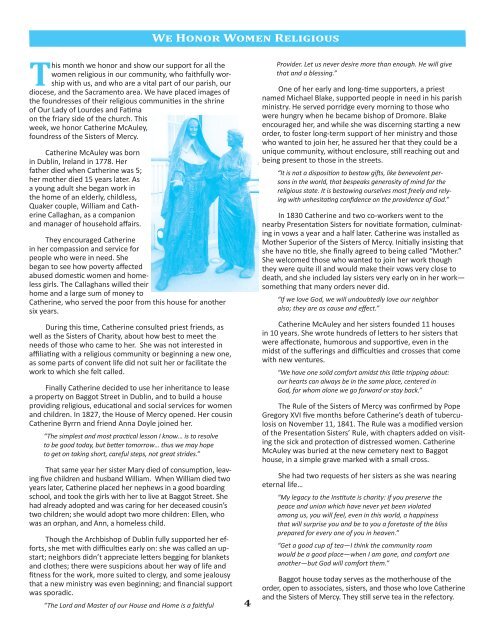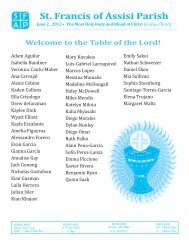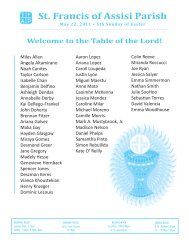6/17 - Saint Francis of Assisi Parish
6/17 - Saint Francis of Assisi Parish
6/17 - Saint Francis of Assisi Parish
Create successful ePaper yourself
Turn your PDF publications into a flip-book with our unique Google optimized e-Paper software.
This month we honor and show our support for all the<br />
women religious in our community, who faithfully worship<br />
with us, and who are a vital part <strong>of</strong> our parish, our<br />
diocese, and the Sacramento area. We have placed images <strong>of</strong><br />
the foundresses <strong>of</strong> their religious communi� es in the shrine<br />
<strong>of</strong> Our Lady <strong>of</strong> Lourdes and Fa� ma<br />
on the friary side <strong>of</strong> the church. This<br />
week, we honor Catherine McAuley,<br />
foundress <strong>of</strong> the Sisters <strong>of</strong> Mercy.<br />
Catherine McAuley was born<br />
in Dublin, Ireland in <strong>17</strong>78. Her<br />
father died when Catherine was 5;<br />
her mother died 15 years later. As<br />
a young adult she began work in<br />
the home <strong>of</strong> an elderly, childless,<br />
Quaker couple, William and Catherine<br />
Callaghan, as a companion<br />
and manager <strong>of</strong> household aff airs.<br />
They encouraged Catherine<br />
in her compassion and service for<br />
people who were in need. She<br />
began to see how poverty aff ected<br />
abused domes� c women and homeless<br />
girls. The Callaghans willed their<br />
home and a large sum <strong>of</strong> money to<br />
Catherine, who served the poor from this house for another<br />
six years.<br />
During this � me, Catherine consulted priest friends, as<br />
well as the Sisters <strong>of</strong> Charity, about how best to meet the<br />
needs <strong>of</strong> those who came to her. She was not interested in<br />
affi lia� ng with a religious community or beginning a new one,<br />
as some parts <strong>of</strong> convent life did not suit her or facilitate the<br />
work to which she felt called.<br />
Finally Catherine decided to use her inheritance to lease<br />
a property on Baggot Street in Dublin, and to build a house<br />
providing religious, educa� onal and social services for women<br />
and children. In 1827, the House <strong>of</strong> Mercy opened. Her cousin<br />
Catherine Byrrn and friend Anna Doyle joined her.<br />
“The simplest and most prac� cal lesson I know… is to resolve<br />
to be good today, but be� er tomorrow… thus we may hope<br />
to get on taking short, careful steps, not great strides.”<br />
That same year her sister Mary died <strong>of</strong> consump� on, leaving<br />
fi ve children and husband William. When William died two<br />
years later, Catherine placed her nephews in a good boarding<br />
school, and took the girls with her to live at Baggot Street. She<br />
had already adopted and was caring for her deceased cousin’s<br />
two children; she would adopt two more children: Ellen, who<br />
was an orphan, and Ann, a homeless child.<br />
Though the Archbishop <strong>of</strong> Dublin fully supported her efforts,<br />
she met with diffi cul� es early on: she was called an upstart;<br />
neighbors didn’t appreciate le� ers begging for blankets<br />
and clothes; there were suspicions about her way <strong>of</strong> life and<br />
fi tness for the work, more suited to clergy, and some jealousy<br />
that a new ministry was even beginning; and fi nancial support<br />
was sporadic.<br />
“The Lord and Master <strong>of</strong> our House and Home is a faithful<br />
W� H���� W���� R��������<br />
4<br />
Provider. Let us never desire more than enough. He will give<br />
that and a blessing.”<br />
One <strong>of</strong> her early and long-� me supporters, a priest<br />
named Michael Blake, supported people in need in his parish<br />
ministry. He served porridge every morning to those who<br />
were hungry when he became bishop <strong>of</strong> Dromore. Blake<br />
encouraged her, and while she was discerning star� ng a new<br />
order, to foster long-term support <strong>of</strong> her ministry and those<br />
who wanted to join her, he assured her that they could be a<br />
unique community, without enclosure, s� ll reaching out and<br />
being present to those in the streets.<br />
“It is not a disposi� on to bestow gi� s, like benevolent persons<br />
in the world, that bespeaks generosity <strong>of</strong> mind for the<br />
religious state. It is bestowing ourselves most freely and relying<br />
with unhesita� ng confi dence on the providence <strong>of</strong> God.”<br />
In 1830 Catherine and two co-workers went to the<br />
nearby Presenta� on Sisters for novi� ate forma� on, culminating<br />
in vows a year and a half later. Catherine was installed as<br />
Mother Superior <strong>of</strong> the Sisters <strong>of</strong> Mercy. Ini� ally insis� ng that<br />
she have no � tle, she fi nally agreed to being called “Mother.”<br />
She welcomed those who wanted to join her work though<br />
they were quite ill and would make their vows very close to<br />
death, and she included lay sisters very early on in her work—<br />
something that many orders never did.<br />
“If we love God, we will undoubtedly love our neighbor<br />
also; they are as cause and eff ect.”<br />
Catherine McAuley and her sisters founded 11 houses<br />
in 10 years. She wrote hundreds <strong>of</strong> le� ers to her sisters that<br />
were aff ec� onate, humorous and suppor� ve, even in the<br />
midst <strong>of</strong> the suff erings and diffi cul� es and crosses that come<br />
with new ventures.<br />
“We have one solid comfort amidst this li� le tripping about:<br />
our hearts can always be in the same place, centered in<br />
God, for whom alone we go forward or stay back.”<br />
The Rule <strong>of</strong> the Sisters <strong>of</strong> Mercy was confi rmed by Pope<br />
Gregory XVI fi ve months before Catherine’s death <strong>of</strong> tuberculosis<br />
on November 11, 1841. The Rule was a modifi ed version<br />
<strong>of</strong> the Presenta� on Sisters’ Rule, with chapters added on visiting<br />
the sick and protec� on <strong>of</strong> distressed women. Catherine<br />
McAuley was buried at the new cemetery next to Baggot<br />
house, in a simple grave marked with a small cross.<br />
She had two requests <strong>of</strong> her sisters as she was nearing<br />
eternal life…<br />
“My legacy to the Ins� tute is charity: if you preserve the<br />
peace and union which have never yet been violated<br />
among us, you will feel, even in this world, a happiness<br />
that will surprise you and be to you a foretaste <strong>of</strong> the bliss<br />
prepared for every one <strong>of</strong> you in heaven.”<br />
“Get a good cup <strong>of</strong> tea—I think the community room<br />
would be a good place—when I am gone, and comfort one<br />
another—but God will comfort them.”<br />
Baggot house today serves as the motherhouse <strong>of</strong> the<br />
order, open to associates, sisters, and those who love Catherine<br />
and the Sisters <strong>of</strong> Mercy. They s� ll serve tea in the refectory.




